Few issues are as alarming as the iMac black screen. One moment you're working productively, and the next, your display is completely unresponsive, even though you might still hear the computer's fans or startup chime. This sudden problem, often called the "black screen of death," is stressful, but it's often fixable with a few simple steps.
This guide is designed to help you diagnose and resolve the iMac black screen issue without needing a trip to the repair shop. We will walk you through a series of proven solutions, from simple key combinations to essential system resets, to get your display working again.
Table of Content
What Is an iMac Black Screen of Death, and How Does It Manifest?
iMac black screen is a problem where your screen won't turn on, and you can't see anything on your computer. You can't open applications or enter settings; your computer will act like you've turned it off, but it will still have power.
A black screen can manifest in several ways, such as:
- No display - When you power on your computer, the screen becomes black, with no Apple logo at startup.
- Black screen with a cursor - You may also see a black screen with only a cursor on it. However, when you click your mouse, the cursor doesn't interact with anything.
- Unexpected black screen - The black screen may also suddenly appear while you use your iMac computer.
Common Causes of an iMac Screen That Goes Black
Numerous reasons may lead to the iMac black screen, including:
- Software malfunctions - Operating system errors, outdated macOS versions, data corruption, and other software issues may cause your iMac screen to keep going black.
- Firmware issues - If your firmware suddenly malfunctions, it won't be able to make your computer run properly.
- External devices - Faulty external devices like hard drives can affect your computer's performance, causing your iMac with no display.
- Power issues - Your iMac may not receive enough power to run, making it impossible to access your data.
- Physical damage - If you've exposed your computer to dust, humidity, and other factors, it may have suffered physical damage. The drives and RAM may be unable to run in such scenarios.
Recover Your Data Immediately if Your iMac Screen Is Going Black
Before fixing the iMac black screen of death, you must recover and back up your data. Some solutions may lead to data loss, so ensure you have all your valuable files before doing anything to your iMac device.
To recover data from your computer when the iMac screen goes black, you will need a working computer, a blank USB drive, and a third-party recovery software solution. In this tutorial, we have chosen Wondershare Recoverit. It's among the best data recovery tools for Mac to retrieve data from a crashed Mac. It also has one of the highest success rates (around 95%), making it efficient and reliable.
- Recovers data from 2000+ storage media, including computers/laptops, external hard drives, USB drives, SD cards, etc.
- Enables recovery of data lost due to system crash, disk corruption, virus attack, and more.
- Works with all popular file systems, such as NTFS, FAT, HFS+, and APFS, among others.

Download Wondershare Recoverit on a working computer to start your recovery journey and prepare a blank USB. Follow the video tutorial or the instructions below:
- Open the program and head to System Crashed Computer. Click Start.
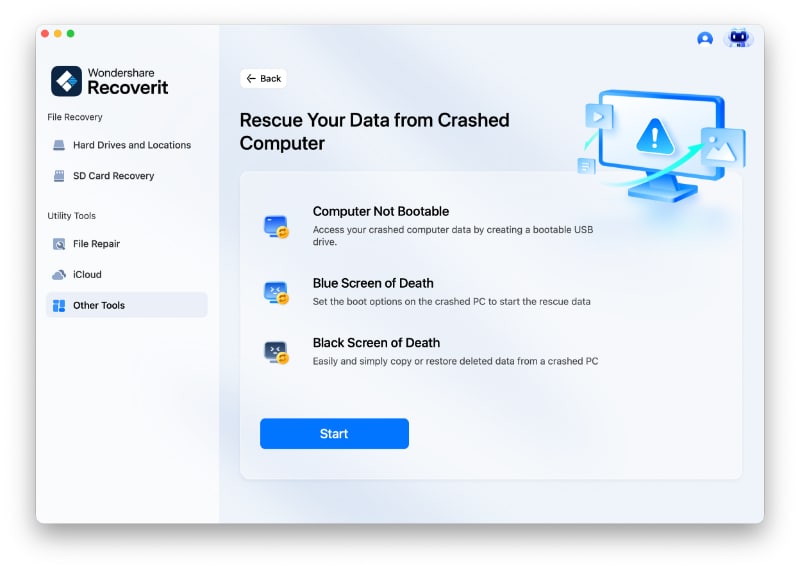
- Insert a blank USB drive and select it. Click Create to continue.
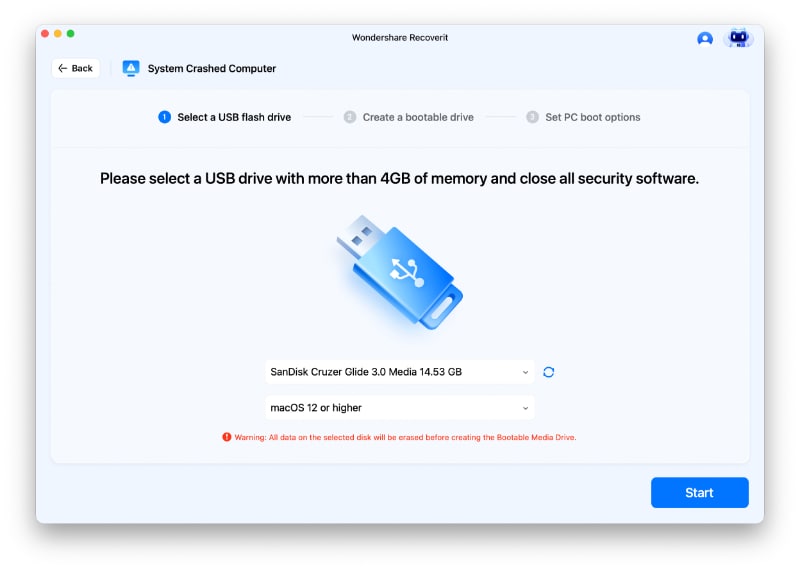
- The program will ask you to format your drive. Click Format to accept.
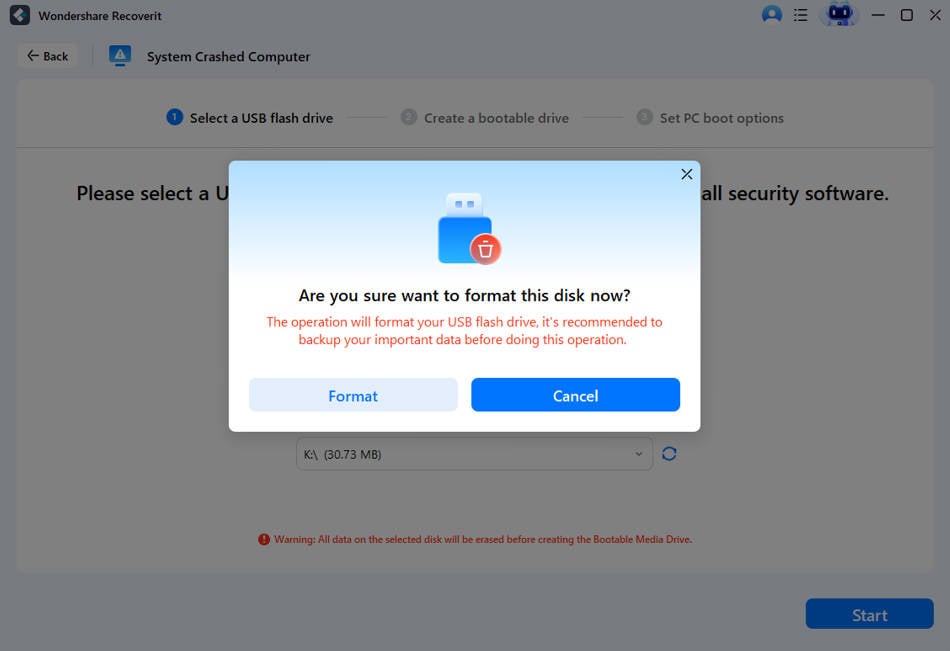
- The software will then make your USB bootable.

- After a few minutes, your bootable USB drive for Mac will be ready. Plug it into the iMac with the black screen issue.
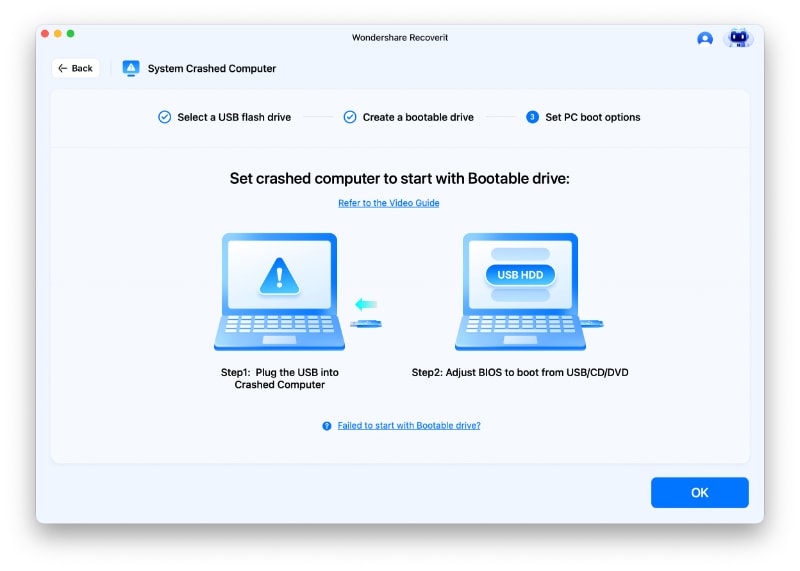
- Adjust the BIOS to boot from the USB device by pressing the BIOS entry key when restarting the device.
- Click Recoverit Bootable Media when it appears.
- You can choose between Hard Disk Copy and Data Recovery options.
- Connect an external hard drive to the iMac.
- Select the files you wish to copy.
- Choose the external drive you want to copy data to and click Start Copy.
Saving your digital valuables will only take a few minutes.
How To Fix the iMac Black Screen of Death
Below are eight proven fixes for solving the iMac black screen issue.
Fix 1: Reset PRAM
PRAM (Parameter Random Access Memory) stores all the core features of your Mac device. The most crucial settings information it holds relates to the operating system, which can frequently malfunction and lead to the iMac blank screen issue. Resetting the PRAM will fix minor and complex problems causing the iMac black screen to appear.
Here's how to reset your PRAM:
- Shut down your computer and disconnect USB devices.
- Press the Power button to turn on your iMac.

- Press the Option + Command + P + R keys on your keyboard. Hold them for 20 seconds.

- Release the keys when the Mac finishes rebooting.
This process will only take a few minutes and might fix the cause of your black screen. If it doesn't resolve the problem, it will at least give your iMac a fresh start.
Fix 2: Boot Your iMac in Safe Mode
Safe Mode is a diagnostic macOS environment that lets you check for and solve software issues causing your iMac to turn on with a black screen. Once you boot your Mac in Safe Mode, your computer will detect and resolve minor hiccups with your software and clean unnecessary cache. You can try this method by following the steps below:
- Turn off your iMac.
- Once your computer is off, press the Power button.
- Press and hold the Shift key immediately afterward.

- Once your iMac turns on, log into your account to access Safe Mode.

While in the Safe Mode, your computer will only run reliable applications that aren't damaging your computer. After booting the PC in Safe Mode, you should leave it on for a few hours to see whether it is still running. If you experience issues with the black screen in Safe Mode, you should try another solution. However, if the computer runs normally, you should delete applications and programs you cannot find in the safe option to resolve issues with the black screen.
Fix 3: Adjust Energy Saver Settings
Your iMac screen suddenly going black may not indicate severe software or physical damage. Instead, it may have something to do with your Energy Saver settings. Every Mac device has this option to preserve its health by consuming as little energy as possible.
During this process, your Mac's screen may suddenly go black to preserve energy. You can either move your mouse around to activate the screen or turn the brightness up on your keyboard to check whether it is. Here's how you can change your Energy Saver Settings on your iMac:
- Boot your iMac in Safe Mode by following the steps above.
- Click the Apple logo and head to System Preferences.

- Select Energy Saver.

You can adjust numerous settings to your preferences and resolve the iMac black screen problem.
Fix 4: Purge RAM in Terminal
Sometimes, your RAM may be unable to handle more actions on your computer. For instance, if you have too many applications running in the background, another one might be too much for the RAM, causing your iMac screen to go black while still running. To fix it, you can clear your RAM by following this guide:
- Boot your device in Safe Mode by following the steps from the Fix 2.
- Open the Terminal.

- Enter the sudo purge command and press Return.
- The program will ask you to input your password to complete the process.

The Terminal will clear your RAM, enabling you to run your favorite programs without issues.
Fix 5: Remove Excessive Files on the Desktop
Excessive or junk files can significantly impact your device's performance, especially if they have accumulated for some time. Remove them to let your iMac computer breathe and fix the black screen. Here's how to do it:
- Boot your device in Safe Mode by following the steps provided in Fix 2.
- Navigate to Finder > Go.

- Press the Option key and select Library when it appears.

- Head to Caches.

- Delete the cache files.
Fix 6: Reset the System Management Controller (SMC)
The System Management Controller, or SMC, controls the physical components of your iMac, including the power supply. If the SMC starts acting weird, it may directly influence the amount of power your computer receives, resulting in an iMac that turns on with a black screen or a completely dead screen. To fix this issue, reset the SMC by following these steps:
- Turn off your computer and unplug the power cord.

- Wait 15 seconds before plugging the power cord back in.
- Wait another five seconds before turning on your iMac.
The abovementioned guide was for desktop iMac devices. You can follow the guide below if your MacBook screen goes black:
- Power off your device.
- Press the Control + Alt + Shift keys on your keyboard and hold them for 7 seconds.
- After that, hold the keys, while also pressing and holding the power button. Keep holding for another 7 seconds.
If you have an Apple Silicon device, you can reset your SMC by restarting your device.
Your computer will now receive enough power to run correctly.
Fix 7: Check & Fix the Temperature
If your iMac is overheating, it can lead to physical damage and, inevitably, the black screen of death. Frequently check your CPU and GPU temperatures and keep the device cool to ensure maximum performance.
You can check the temperature through Terminal by following this guide:
- Boot your device in Safe Mode by following the steps from Fix 2.
- Open the Terminal.
- Input the sudo powermetrics --samplers smc |grep -i "CPU die temperature" command and press Return.

You'll see the CPU temperature in the Terminal. If it exceeds 90℃, try to cool the iMac down. You can do so by vacuuming the air vents and ensuring the best airflow. You can also put a cooling element next to your computer to make the process faster. Ensure your iMac isn't in direct sunlight to avoid another heat source.
Fix 8: Contact Professional Support
If your iMac screen goes black and you've tried the troubleshooting steps above without success, it's time to contact professional support. Reach out to Apple Support or an authorized service provider to get expert assistance in fixing the issue, ensuring your iMac is restored to its optimal working condition.
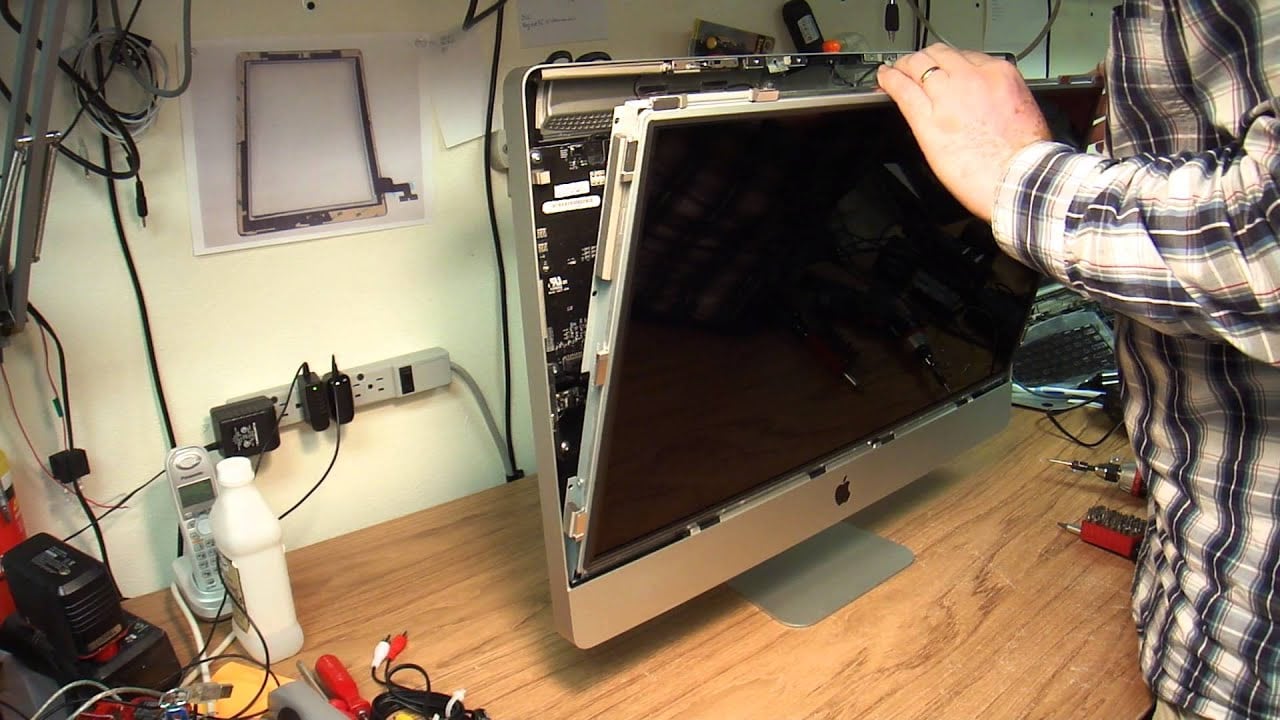
Conclusion
Turning on your iMac computer only for the black screen of death to greet you can be frustrating. If you are currently in this scenario and wonder how to fix this issue, you are in the right place. The solutions above are the best ways to eliminate the black screen and give your iMac a fresh start.
Before trying any of the methods above, recover and back up your data to avoid data loss. Wondershare Recoverit is the best recovery solution to retrieve your data in minutes.
FAQs
-
I can hear my iMac running, but the screen is black. What does this mean?
This is a classic symptom of the iMac black screen issue and often points to a software glitch, a problem with display settings, or a PRAM/NVRAM corruption rather than a complete hardware failure. Your first step should be to try resetting the SMC and NVRAM/PRAM. -
Can a software update cause my computer to have a black screen?
Yes, a failed or corrupted macOS update is a common cause of a computer black screen. If the issue started immediately after an update, booting into Safe Mode can help diagnose the problem, as it loads only essential system files and can allow you to complete or revert the update. -
What is the difference between an iMac black screen and a Mac blue screen?
An iMac black screen usually means the display is not receiving a signal or has a power issue, even if the computer is on. A Mac computer blue screen (or a screen that is stuck on a solid color) typically indicates a startup issue where the OS is trying to load but is stuck on a specific process, often related to peripherals or login items. -
How do I force a restart on my iMac when the screen is black?
To perform a hard reboot, press and hold the power button on the back of your iMac for about 10 seconds. You should hear the computer power down completely. Wait for another 10-15 seconds before pressing the power button again to turn it back on. This often resolves temporary glitches.



 ChatGPT
ChatGPT
 Perplexity
Perplexity
 Google AI Mode
Google AI Mode
 Grok
Grok























